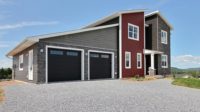Home Energy Rating System Index
Making the Grade
















The Home Energy Rating System Index, which was developed by Residential Energy Services Network or RESNET, is the industry standard by which a home’s energy efficiency is measured. It’s frequently referenced as the new miles-per-gallon sticker for homes, and for good reason. It’s a comprehensive measure of a home’s energy efficiency that is easy for both the tradesman and the average Joe to understand.
A home receives a HERS Index score when a RESNET-certified home energy rater analyzes its energy consumption habits. The HERS measure is a handy reference for builders interested in improving their construction practices, as well as a great marketing tool when they want to sell homes that have achieved desirable scores. The tool is not just for builders, though. Homeowners also use the tool to identify ways to improve the energy efficiency of their own homes as they work to reduce utility bills. Homebuyers can use it to comparison shop as HERS Index scores can be included on real estate MLS listings. Further, the Department of Energy, Department of Housing and Urban Development and the Environmental Protection Agency have also adopted the measurement standard as their own. In fact, several jurisdictions throughout the country have incorporated the HERS Index Score into their building energy codes.
How it Works
A certified home energy rater assesses the energy efficiency of a home and assigns it a relative performance score. The lower the score, the more energy-efficient the home and the lower the bills. Variables such as above- and below-grade exterior walls, floors over unconditioned spaces, ceilings, roofs, attics, foundations, crawlspaces, windows, doors, vents, ductwork, HVAC systems, water heating systems and the thermostat are all taken into account during the assessment.
Despite the comprehensive nature of the HERS program today, early on RESNET required very little investigation into the installation practices of insulation—a key component to an energy-wise structure. In fact, there was no discernment between a home with properly installed insulation and one with poorly installed insulation. If a home had R-13 fiberglass insulation inside its walls, for instance, then the insulation was considered to provide an R-13 value. As professionals involved in the business of wall and ceiling assemblies, we know better. Fortunately, RESNET has updated their requirements for what measures up to standard and what doesn’t.
When a home energy rater reviews today, he or she now records each assembly as having Grade I, Grade II or Grade III quality. Grade I is the highest rating of installation quality and is the level for which every installer should aim. This grade confirms that the insulation was installed according to the manufacturer’s instructions, completely fills the cavity and is not compressed. While any type of insulation can be used inside energy-rated wall and attic spaces, some are simply a better fit than others.
Fiberglass Insulation Makes the Grade
When it comes to achieving a RESNET Grade I for the installation of insulation, fiberglass is more than a viable option. It is cost effective and can easily achieve the stated R-value so long it is installed properly. Installation is naturally key to energy efficiency for any chosen insulation material.
Fiberglass insulation, be it batts or blown-in loose fill, works because its strands form millions of tiny air pockets that trap air and resist the flow of heat. In winter, fiberglass insulation retards the movement of heat from inside the home to the outdoors. This keeps the house warmer. In the summer the insulation helps prevent the outside heat from entering the home through walls and ceilings. This resistance to heat flow is of course called R-value. The higher the R-value, the more resistance properly installed insulation gives to the natural flow of heat. Poorly installed insulation will reduce the thermal performance of the wall system regardless of the material selected or stated R-value. It should also be noted that in a similar manner, fiberglass insulation is also excellent at controlling noise to keep a home quieter.
Insulation contractors have come to rely on fiberglass insulation because it is permanent, won’t settle or deteriorate with age, is easy to install, and is noncombustible. Quality brands also have their fiberglass insulation materials regularly tested for product performance by reputable third-party laboratories like Home Innovation Research Labs. In fact, fiberglass has become the most widely used material for insulation in the United States and is helping builders lower their homes’ HERS Index score when installed to RESNET Grade I specifications.
Proper Install Makes Perfect
Attaining the top RESNET grade is not difficult but does require the installer to do his or her due diligence. Proper installation extends beyond selecting quality insulation and begins well before the insulation is physically placed into the wall. Proper planning is a key part to any quality insulation job.
First the installer should make sure the correct R-value is used to meet building code requirements. It also pays to make sure the correct vapor retarder
is used when one is required.
Next it is critical for the contractor to inspect the home’s walls to ensure that the entire building envelope provides a continuous and consistent layer of thermal performance while also addressing other key needs like air tightness and moisture management. All of these play a key role in the performance of the wall system. All cavities where insulation is to be installed will have all six sides of the cavity in contact with insulation once the wall system is complete. Specifically, there should be sheathing on the exterior, studs on four sides, and a wall finish that will go on the interior. The exceptions being attics above ceilings, space under floors and above an unvented crawlspace, rim or band joists in conditioned spaces, and conditioned basement or crawlspace walls.
The installer should also inspect the air barrier system prior to insulating. This means that a continuous plane of air-impermeable materials—typically a combination of housewrap and sealants like caulk and spray foam—should be in place that separates the inside of the home from the outside. Any path through the walls, floors and ceilings in which air can move between the inside and outside of the house must be sealed before insulating begins. Common culprits for air leaks include holes for wires, electrical boxes and plumbing—it is the adjoining interfaces between systems and materials that are the most susceptible for leakage.
Once the contractor has deemed the home ready for insulation, every effort should be made to ensure there are no gaps, voids, or compression in the installed insulation, and that it is fully aligned with the interior wall surface. Insulation must fully fit the cavity from side to side and top to bottom. This may require that a combination of batt and blown-in fiberglass insulation be used depending on the situation.
To achieve Grade I with batts, only occasional or very small gaps are allowed. For blown-in fiberglass insulation, Grade I stipulations require the insulation fills netted wall cavities and flows easily around wiring and other obstructions to provide a uniform insulating layer without gaps or voids. There must also be a consistent density behind the netting.
Essentially when HERS raters inspect insulation installations, they look for compression, voids and gaps. By following the manufacturer’s guidelines and working with quality insulation, a Grade I should be easy to achieve.
Looking for a reprint of this article?
From high-res PDFs to custom plaques, order your copy today!
















